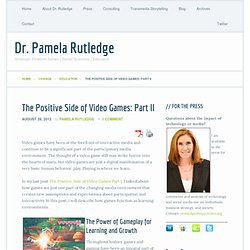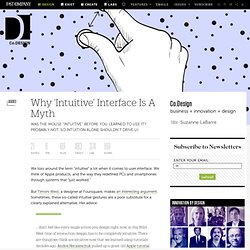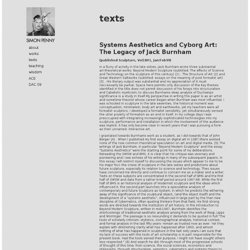

Trope November news. Keith Armstrong’s revamped Embodied Media site ...) The Positive Side of Video Games: Part II — Dr. Pamela Rutledge. Video games have been at the forefront of interactive media and continue to be a significant part of the participatory media environment.

The thought of a video game still may strike horror into the hearts of many, but video games are just a digital manifestation of a very basic human behavior: play. Playing is where we learn. In my last post The Positive Side of Video Games Part I, I talked about how games are just one part of the changing media environment that creates new assumptions and expectations about participation and interactivity In this post, I will describe how games function as learning environments. The Power of Gameplay for Learning and Growth Throughout history, games and gaming have been an integral part of human expression of culture and identity, facilitating collaboration and creativity. The bulk of video game-related research has focused on the interactivity, cognitive resources, and impact of content (Klimmt & Hartmann, 2009).
Games Expand the Sense of Self Gee, J. Cimatics 2008, Non Solo Vjing. Primal Source (video documentation) Paul Sermon: Telematic Dreaming, Telematic Installation 1992. Interactive installation intersecting organic and technological cultures. Why ‘Intuitive’ Interface Is A Myth. We toss around the term “intuitive” a lot when it comes to user interface.

We think of Apple products, and the way they redefined PCs and smartphones through systems that “just worked.” But Timoni West, a designer at Foursquare, makes an interesting argument. Sometimes, these so-called intuitive gestures are a poor substitute for a clearly explained alternative. Her advice: … don’t feel like every single action you design right now, in this Wild West time of interaction design, has to be completely intuitive. In other words, don’t strive above all else to make your interface intuitive, just make it very easy to learn. Seriously, would you have picked up an iPhone with Google Maps loaded and thought to yourself, "I can pinch this glass screen to enlarge the whole image"? Picking your nose is intuitive. Read more here. [Hat tip: Matt Buchanan] [Image: Pinch to Zoom via Shutterstock/Illustration: Kelly Rakowski/Co.Design] Wafaa Bilal. Wafaa Bilal's childhood in Iraq was defined by the horrific rule of Saddam Hussein, two wars, a bloody uprising, and time spent interned in chaotic refugee camps in Kuwait and Saudi Arabia.

Bilal eventually made it to the U.S. to become a professor and a successful artist, but when his brother was killed at a U.S. checkpoint in 2005, he decided to use his art to confront those in the comfort zone with the realities of life in a conflict zone. Thus the creation and staging of "Domestic Tension," an unsettling interactive performancepiece: for one month, Bilal lived alone in a prison cell-sized room in the line of fire of a remote-controlled paintball gun and a camera that connected him to internet viewers around the world. Visitors to the gallery and a virtual audience that grew by the thousands could shoot at him 24 hours a day. Review by Publishers Weekly. Wafaa Bilal discusses Shoot an Iraqi. Simon Penny. In a flurry of activity in the late sixties, Jack Burnham wrote three substantial art-theoretical works: Beyond Modern Sculpture (subtitled: The effects of Science and Technology on the sculpture of this century) [1] , The Structure of Art [2] and Great Western Saltworks (subtitled: essays on the meaning of post formalist art) [3] .

His literary output was substantial and my appreciation of it must neccessarily be partial. Space here permits only discussion of the key themes identified in the title does not permit discussion of his forays into structuralism and Cabalistic mysticism; to discuss Burnhams deep analysis of Duchamps significance is a study in itself.My perspective in writing this paper is as an artist and sometime theorist whose career began when Burnham was most influential. I was schooled in sculpture in the late seventies, the historical moment was conceptualism, minimalism, body art and earthworks, yet my teachers were all formalist sculptors.
. [3] George Braziller 1974. Design + research. Primal Source Specially commissioned by the City of Santa Monica, California, for Glow 08, Primal Source was an all-night performance/installation brought to life through the active participation of festival-goers (estimated at approx. 200,000 over the course of the night).

Located on the beach near the Pier in an area that had been specifically landscaped over the course of several days, and making use of a large-scale outdoor waterscreen/mist projection system, the mirage-like installation glowed with colours and ebullient patterns created in response to the competing and collaborative voices, music and screams of people nearby. Responding to sounds emanating from the crowd, the system's modes changed every few minutes depending on how active the crowd participation was (more quickly when there was more noise).
Each mode responded in a slightly different way to the individual voices and sounds picked up by 8 microphones distributed towards the front. Primal Source video documentation.